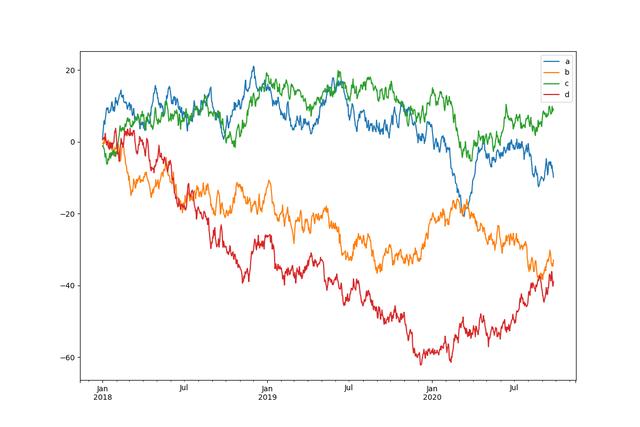您好,登錄后才能下訂單哦!
您好,登錄后才能下訂單哦!
這篇文章主要介紹了Python中Pandas知識點有哪些,具有一定借鑒價值,感興趣的朋友可以參考下,希望大家閱讀完這篇文章之后大有收獲,下面讓小編帶著大家一起了解一下。
pandas 是基于NumPy 的一種工具,該工具是為了解決數據分析任務而創建的。Pandas 納入了大量庫和一些標準的數據模型,提供了高效地操作大型數據集所需的工具。pandas提供了大量能使我們快速便捷地處理數據的函數和方法。你很快就會發現,它是使Python成為強大而高效的數據分析環境的重要因素之一。

1.pandas數據結構的介紹
Series:一維數組,與Numpy中的一維array類似。二者與Python基本的數據結構List也很相近。Series如今能保存不同種數據類型,字符串、boolean值、數字等都能保存在Series中。
Time- Series:以時間為索引的Series。
DataFrame:二維的表格型數據結構。很多功能與R中的data.frame類似。可以將DataFrame理解為Series的容器。
Panel :三維的數組,可以理解為DataFrame的容器。
2.Series的操作
2.1 對象創建 2.1.1 直接創建2.1.2 字典創建
import pandas as pd import numpy as np # 直接創建 s = pd.Series(np.random.randn(5), index=['a','b','c','d','e']) print(s) # 字典(dict)類型數據創建 s = pd.Series( {'a':10, 'b':20, 'c':30}, index=['b', 'c', 'a', 'd']) OUT: a -0.620323 b -0.189133 c 1.677690 d -1.480348 e -0.539061 dtype: float64 OUT: a 10 b 20 c 30 dtype: int642.2 查看數據 切片、索引、dict操作 Series既然是一維數組類型的數據結構,那么它支持想數組那樣去操作它。通過數組下標索引、切片都可以去操作他,且它的data可以是dict類型的,那么它肯定也就支持字典的索引方式。
import pandas as pd import numpy as np s = pd.Series(np.random.randn(5), index=['a','b','c','d','e']) print(s) # 下標索引 print('下標索引方式s[0] = : %s' % s[0]) # 字典訪問方式 print('字典訪問方式s[b] = :%s' % s['b']) # 切片操作 print('切片操作s[2:]\n:%s' % s[2:]) print('a' in s) print('k' in s) OUT: a -0.799676 b -1.581704 c -1.240885 d 0.623757 e -0.234417 dtype: float64 下標索引方式s[0] = : -0.799676067487 字典訪問方式s[b] = :-1.58170351838 切片操作s[2:]: c -1.240885 d 0.623757 e -0.234417 True False2.3 Series的算術操作
import pandas as pd import numpy as np s1 = pd.Series(np.random.randn(3), index=['a','b','c']) s2 = pd.Series(np.random.randn(3), index=['a','b','c']) print(s1+s2) print(s1-s2) print(s1*s2) print(s1/s2) OUT: a 0.236514 b -0.132153 c 0.203186 dtype: float64 a 0.305397 b -1.474441 c -1.697982 dtype: float64 a -0.009332 b -0.539128 c -0.710465 dtype: float64 a -7.867120 b -1.196907 c -0.786252 dtype: float64
3.dataframe的操作
3.1 對象創建
In [70]: data = {'state': ['Ohio', 'Ohio', 'Ohio', 'Nevada', 'Nevada'],'year': [2000, 2001, 20 ...: 02, 2001, 2002],'pop': [1.5, 1.7, 3.6, 2.4, 2.9]} In [71]: data Out[71]: {'pop': [1.5, 1.7, 3.6, 2.4, 2.9], 'state': ['Ohio', 'Ohio', 'Ohio', 'Nevada', 'Nevada'], 'year': [2000, 2001, 2002, 2001, 2002]} # 建立DataFrame對象 In [72]: frame1 = DataFrame(data) # 紅色部分為自動生成的索引 In [73]: frame1 Out[73]: pop state year 0 1.5 Ohio 2000 1 1.7 Ohio 2001 2 3.6 Ohio 2002 3 2.4 Nevada 2001 4 2.9 Nevada 2002 >>> lista = [1,2,5,7] >>> listb = ['a','b','c','d'] >>> df = pd.DataFrame({'col1':lista,'col2':listb}) >>> df col1 col2 0 1 a 1 2 b 2 5 c 3 7 d3.2 選擇數據
In [1]: import numpy as np ...: import pandas as ...: df = pd.DataFrame In [2]: df Out[2]: a b c 0 0 2 4 1 6 8 10 2 12 14 16 3 18 20 22 4 24 26 28 5 30 32 34 6 36 38 40 7 42 44 46 8 48 50 52 9 54 56 58 In [3]: df.loc[0,'c'] Out[3]: 4 In [4]: df.loc[1:4,['a','c']] Out[4]: a c 1 6 10 2 12 16 3 18 22 4 24 28 In [5]: df.iloc[0,2] Out[5]: 4 In [6]: df.iloc[1:4,[0,2]] Out[6]: a c 1 6 10 2 12 16 3 18 22
3.3 函數應用
frame = pd.DataFrame(np.random.randn(4, 3), columns=list('bde'), index=['Utah', 'Ohio', 'Texas', 'Oregon']) frame np.abs(frame) OUT: b d e Utah 0.204708 0.478943 0.519439 Ohio 0.555730 1.965781 1.393406 Texas 0.092908 0.281746 0.769023 Oregon 1.246435 1.007189 1.296221 f = lambda x: x.max() - x.min() frame.apply(f) OUT: b 1.802165 d 1.684034 e 2.689627 dtype: float64 def f(x): return pd.Series([x.min(), x.max()], index=['min', 'max']) frame.apply(f) b d e Utah -0.20 0.48 -0.52 Ohio -0.56 1.97 1.39 Texas 0.09 0.28 0.77 Oregon 1.25 1.01 -1.303.4 統計概述和計算
df = pd.DataFrame([[1.4, np.nan], [7.1, -4.5], [np.nan, np.nan], [0.75, -1.3]], index=['a', 'b', 'c', 'd'], columns=['one', 'two']) df OUT: one two a 1.40 NaN b 7.10 -4.5 c NaN NaN d 0.75 -1.3 df.info() df.describe() <class 'pandas.core.frame.DataFrame'> Index: 4 entries, a to d Data columns (total 2 columns): one 3 non-null float64 two 2 non-null float64 dtypes: float64(2) memory usage: 256.0+ bytes OUT: one two count 3.000000 2.000000 mean 3.083333 -2.900000 std 3.493685 2.262742 min 0.750000 -4.500000 25% 1.075000 -3.700000 50% 1.400000 -2.900000 75% 4.250000 -2.100000 max 7.100000 -1.300000
3.5 數據讀取
data = pd.read_csv('./dataset/HR.csv') data.info() out: <class 'pandas.core.frame.DataFrame'> RangeIndex: 14999 entries, 0 to 14998 Data columns (total 10 columns): satisfaction_level 14999 non-null float64 last_evaluation 14999 non-null float64 number_project 14999 non-null int64 average_montly_hours 14999 non-null int64 time_spend_company 14999 non-null int64 Work_accident 14999 non-null int64 left 14999 non-null int64 promotion_last_5years 14999 non-null int64 sales 14999 non-null object salary 14999 non-null object dtypes: float64(2), int64(6), object(2) memory usage: 1.1+ MB data = pd.read_csv('./dataset/movielens/movies.dat', header=None, names=['name', 'types'], sep='::', engine='python') data.head() OUT: name types 1 Toy Story (1995) Animation|Children's|Comedy 2 Jumanji (1995) Adventure|Children's|Fantasy 3 Grumpier Old Men (1995) Comedy|Romance 4 Waiting to Exhale (1995) Comedy|Drama 5 Father of the Bride Part II (1995) Comedy data = pd.read_excel('./dataset/my_excel.xlsx', sheet_name=1) data.head() ouput: date H1 H2 H3 0 2014-06-01 1 2 3 1 2014-06-02 2 3 4 2 2014-06-03 3 4 5 3 2014-06-04 4 5 6#4. Time- Series的操作
生成日期范圍:
import pandas as pd pd.data_range('20190313',periods=10) OUT: DatetimeIndex(['2019-03-13', '2019-03-14', '2019-03-15', '2019-03-16', '2019-03-17', '2019-03-18', '2019-03-19', '2019-03-20', '2019-03-21', '2019-03-22'], dtype='datetime64[ns]', freq='D')5. 繪圖功能
ts = pd.DataFrame(np.random.randn(1000,4),index=pd.date_range('20180101',periods=1000),columns=list('abcd')) ts = ts.cumsum() ts.plot(figsize = (12,8)) plt.show()
感謝你能夠認真閱讀完這篇文章,希望小編分享的“Python中Pandas知識點有哪些”這篇文章對大家有幫助,同時也希望大家多多支持億速云,關注億速云行業資訊頻道,更多相關知識等著你來學習!
免責聲明:本站發布的內容(圖片、視頻和文字)以原創、轉載和分享為主,文章觀點不代表本網站立場,如果涉及侵權請聯系站長郵箱:is@yisu.com進行舉報,并提供相關證據,一經查實,將立刻刪除涉嫌侵權內容。